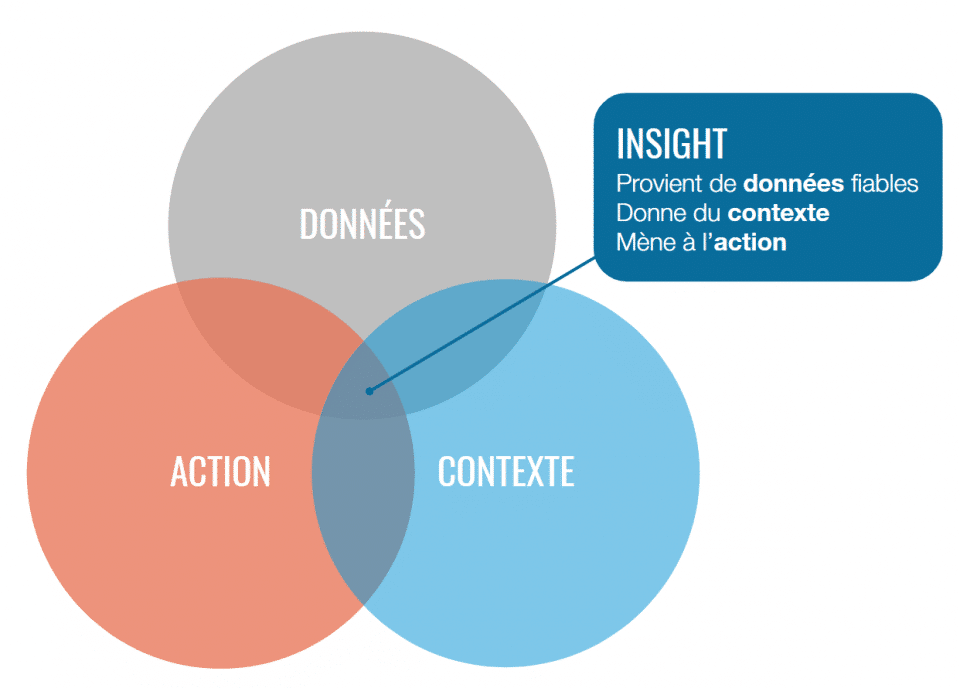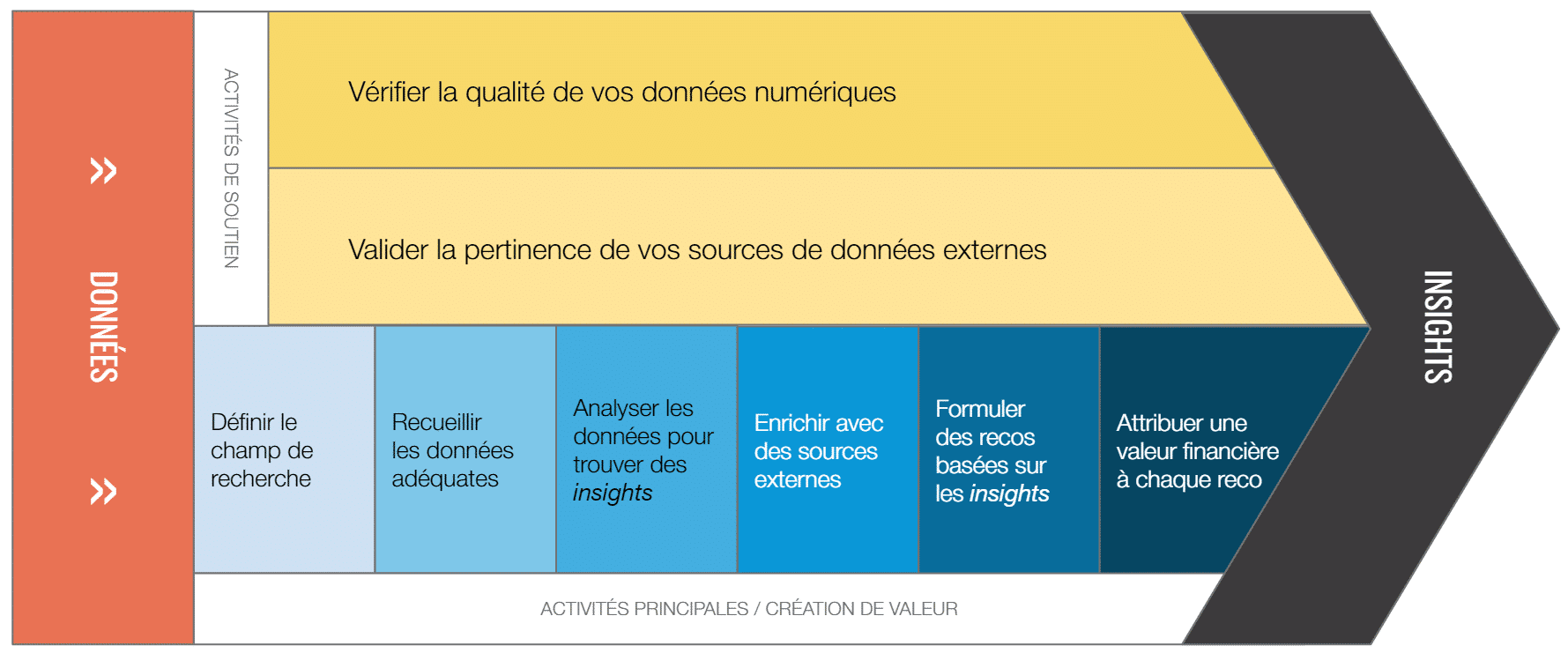Vice-President Data & Customer Experience, Partner
Turning data into actionable insights [Framework]
Vice-President Data & Customer Experience, Partner
Your company's analytics data should make it easier to make decisions and take action. Are they doing it now?
The monumental amount of data and reports available in Google Analytics or Adobe Analytics is no secret. How do you turn this analytics data into actionable insights for your business? No need to be an expert on the subject, this article will not cover data segmentation techniques. Instead, I offer a simple and intuitive framework to address this important challenge. Are you ready?
FIRST OF ALL, WHAT IS AN INSIGHT?
Let's look at the Oxford Dictionary 's definition of insight :
The ability to have a deep and precise understanding of something or someone.
In digital analytics , insights are often associated with information that helps improve an organization's performance through digital initiatives (paid media, A/B testing, SEO, etc.)
But what does it take to generate good insights ?
THREE KEY ELEMENTS FOR RELEVANT INSIGHTS
Like any good recipe, you need the right ingredients to produce good insights . Or, as a colleague of mine often says, “ Garbage in, garbage out . The problem is that many analytics reports are simply lists of findings. Take for example, the statement presented in the first example below :
EXAMPLE 1:
“In 2018, our e-commerce revenue reached $1M; this is a 5% increase over the previous year”.
Although this information is an important measure of performance, it is not an insight . Indeed, the information does not make it possible to fully understand the reason behind this growth or the measures to be taken to reproduce it .
EXAMPLE 2:
“In 2018, we generated $1 million in e-commerce (+5% compared to the previous year). This growth is attributable to the launch of our new product X in Quebec and Ontario. The volume of sales of this product is over-indexed compared to other provinces.
Example 2 helps to better understand the increase in sales volume. If you remember the definition of insight from the Oxford dictionary, the words " ability to have a deep and precise understanding of something " now makes perfect sense!
This brings me to an important question when looking for insights : what characterizes a good insight ? These three pillars are fundamental.

(PARENTHESIS) Before even looking for insights, it is essential to know the business objectives of your company. You should also know what Key Performance Indicators ( KPIs ) are associated with these goals. The insights you are trying to derive should impact these metrics and your tactical results. I therefore recommend that you first think about a set of hypotheses or a series of questions that correspond to your business objectives.
1. DATA
RELIABILITY
There are no insights without data , whether qualitative or quantitative. To be sufficiently qualified, your data must be as accurate as possible, because they must be as close to reality as possible. In addition, verifying your data is a good starting point to assess its reliability. To follow best practices, compare your digital analytics data (e-commerce transactions, web form leads ) to your internal or back-end data .
ENRICHED DATA
It is very likely that your internal data is not sufficient to obtain solid insights. Without the use of external sources, it becomes difficult to create complete stories. Resources such as Google Barometer , Google Think or eMarketer can help you complete your data. Online surveys (aimed at collecting attitudinal data) are also an easy way to enrich your data and uncover even more revealing insights .
2. BACKGROUND
Context is what gives meaning to data. In other words, without context, the data is of little use. Analytics thought leaders ( such as Avinash Kaushik ) agree on the importance of putting data in context.
Now, how to set the context? These two questions should allow you to see things more clearly.
- Why are you looking for insights ?
- Who are the potential users (marketing, finance, executives) of these insights ?
To put the data in context, it is possible to establish measures of comparison , or to supplement your data (quantitative) with other categories of data (qualitative). Here are examples of a few ways to add context to your data:
- Compare your data to a business objective or target;
- Compare your data to that of the competition using external sources;
- Compare your segments and audiences with each other;
- Add qualitative data to explain a behavior (eg surveys that explain the motivation of website users);
- Assign a financial value to your findings (e.g. a 20% drop in web leads is equivalent to a loss of revenue of $15,000).
The more context there is, the more the reader will be able to understand the information you want to convey and its importance.
3.ACTION
The insights you generate should help stakeholders make a decision or take action . Actionable insights require more time because they are more specific. Here are two supporting examples:
EXAMPLE 1:
“Our conversion rate dropped 12% and the biggest drop in the funnel was seen during checkout (the steps from the shopping cart to the order confirmation page.)”
EXAMPLE 2:
“The 12% drop in our conversion rate coincides with the addition of our new payment gateways used in the checkout stages. »
Both of these examples can be considered insights , but the second is more of an actionable insight since it identifies the likely cause of the drop. The logical action to take would be to examine the payment system to determine what caused the drop. Is it a technical problem related to the credit card validation system or rather an ergonomic problem related to the form?
SUMMARY OF THIS FRAMEWORK
To conclude, the process of finding insights can be roughly compared to a value chain ( Porter's value chain concept ): the richer the context, the more valuable your insights will be for your company's decision makers. Each activity in this process plays an important role in the end result, as you can see in the graphic below.

I hope this article will help you produce rich insights that will encourage you to take action.
We are convinced of one thing, your digital initiatives should be powered by your data, your insights . Let our team of specialists unlock the potential of your digital data and help you achieve your business goals. Do not hesitate to contact us!








